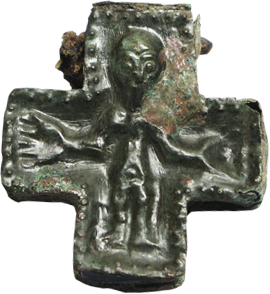The rural house from the migration period to the oldest still standing buildings.
Další svazek z řady RURALIA – the Jean-Marie Pesez conferences on medieval rural archaeology navazuje na konferenci konanou v září r. 2001 v Bad Bederkesa (Německo). Základním tématem se stal vesnický dům, jeho diferenciace a vývoj v časovém rozpětí překračujícím tisíc let. Na výsledné mozaice se podílí přes 60 badatelů z 15 zemí, vedle archeologů připadl významný podíl stavebním historikům a etnografům. Svazek soustředil nebývale rozsáhlou problémovou bilanci příslušné části výzkumu, vybavenou bohatou obrazovou dokumentací. Zároveň tak nabízí mimořádně důležité východisko pro další studium jednoho z nejvýznamnějších historických a kulturně antropologických témat.
(PDF) Obsah – Inhalt – Contents
Památky archeologické – supplementum 15, Prague 2003.
Contents
(88) W. Haio Zimmerman: Vorwort, 1-2.
(89) Emma Bentz: Building function, social space and reconstruction of daily life: a South Scandinavian case study, 3-12.
(90) Jochen Komber: Viking Age architecture in space and time, 13-29.
(91) Hans Skov: The development of rural house types in the old Danish region 800-1500 A.D, 30-33.
(92) Mette Svart Kristiansen: The reconstruction of the layout and functions of a Danish farmstead. The case of farmstead no. II in Taarnby 1100 – 1800, 34-40.
(93) Henriette Rensbro: Medieval farm houses in Eastern Denmark 1200-1600. Archaeological evidence for two different building techniques and reflections on function analysis, 41-44.
(94) Annette Hoff: The farm buildings on basic of Northwest-European lawbooks – ca. 900-1200, 45-48.
(95) Rolf Bärenfänger: Mittelalteriche Bauernhäuser in Ostfriesland, 49-52.
(96) Wolfgang Dörfler: Die ältesten Bauernhausgefüge des Elbe-Wesers Dreiecks, 53-57.
(97) Volker Gläntzer: Das Gulfhaus in Ost-Friesland – eine Innovation des 16. und 17. Jahrhunderts, 58-75.
(98) Heinrich Stiewe: „Fundamentaler“ Wandel? Ländlicher Hausbau des 16. Jahrhunderts in Ostwestfalen und an der mittleren Weser, 76-89.
(99) Dietrich Maschmayer: The development of the Northwest German hall houses and the oldest layers of inventory – Indicators for an agraric revolution in Middle Ages?, 90-100.
(100) Hauke Kenzler: Hausbau in Breunsdorf bei Leipzig. Von der „Kolonisation“ bis die frühe Neuzeit, 101-110.
(101) Rainer Schreg: Haus und Hof im Rahmen der Dorfgenese. Zum Wandel der Bauformen in Südwestdeutschland, 111-122.
(102) Tilmann Marstaller: Haus und Umwelt. Spätmittelalteriche und neuzeitliche Gebäude als Quelle der Umweltgeschichte, 123 – 133.
(103) Michael Schmaedecke: Zur Kontinuität von Getreidespeichern auf Stützen von vorgeschichtlicher Zeit bis die frühe Neuzeit, 134-142.
(104) Benno Furrer: Living in wooden box – Late Medieval log houses in central Switzerland and northern Tessin, 143-150.
(105) Jan van Doesburg: House plans from Late Medieva settlements in Dutch central river area: looking for a needle in a haystack, 151-163.
(106) W. Haio Zimmermann: Kotinuität und Wandel im Hausbau südlich und östlich der Nordsee vom Neolithikum bis zum Mittelalter, 164-168.
(107) Johny De Meulemeester: Fonds de cabane et caves semi-enterées: une réflection etnographique, 169-170.
(108) Judith Alfrey: The little houses. The cottage tradition in NW Wales, 171-174.
(109) Stuart Wrathmell: Some general hypoteses on English Medieval peasant house construction from the 7th to the 17th centuries, 175-186.
(110) Piers Dixon: The medieval peasant building in Scotland: the begining and the end of crucksthtghhh
, 187-200.
(111) Kieran D. O´Conor: Housing in Later Medieval Gaelic Ireland, 201-210.
(112) John Bradley: The rural house in Medieval Ireland, 211-215.
(113) André Bazzana: La maison rurale dans la pénisule ibérique: un atelier d´ethno-archéologie, 216-231.
(114) Jean-Michel Poisson: La maison rurale médiévale en Sardaigne: un atelier d´ethnoarchéologie, 232-239.
(115) Konrad Bedal: Spätmittelaltericher bäuerlicher Hausbau in Süddeutschland. Versuch eines Überblicks – Bestand, Formen und Befunde, 240-256.
(116) Sabine Felgenhauer-Schmiedt: Die Bauerhäuser der Wüstung Hard, Niederösterreich, überlegungen zun dreiteiligen Haus, 257-263.
(117) Matej Ruttkay: Der ländliche Hausbau des 5. Bis 15. Jh im nördlichen Karpatenbecken (Slowakei), 264-271.
(118) Miklós Takács: Der Hausbau in Ungarn vom 2. Bis zum 13. Jahrhundert n. Chr. – ein Zeitalter einheitlicher Grubenhaüser?, 272-290.
(119) Zsuzsa Miklós – Márta Vizi: Beiträge zur Siedlungsgeschichte des mittelalterichen Marktfleckens Ete, 291-307.
(120) András Pálóczi-Horváth: Development of the Late-Mediavel house in Hungary, 308-319.
(121) Tibor Sabján: Reconstruction of Medieval pit-houses, 320-332.
(122) Nebojša Stanojev: Les maison du loess de Pannonie et des communautés du Moyen Âge, 333-338.
(123)Philippe Mignot – Denis Henrotay: L´habitat rural médiéval au sud le Meuse de la fouille au bâti conservé, 339-346.
(124) Jan Klápště – Martin Ježek – Martin Tomášek: The medieval peasant house in Bohemia – continuity and change, 347-356.
(125) Heiko Steuer: Zusammenfassende Gedanken und Fragen aus der Sicht der Archälogie, 357-360.



 ENGLISH VERSION
ENGLISH VERSION
